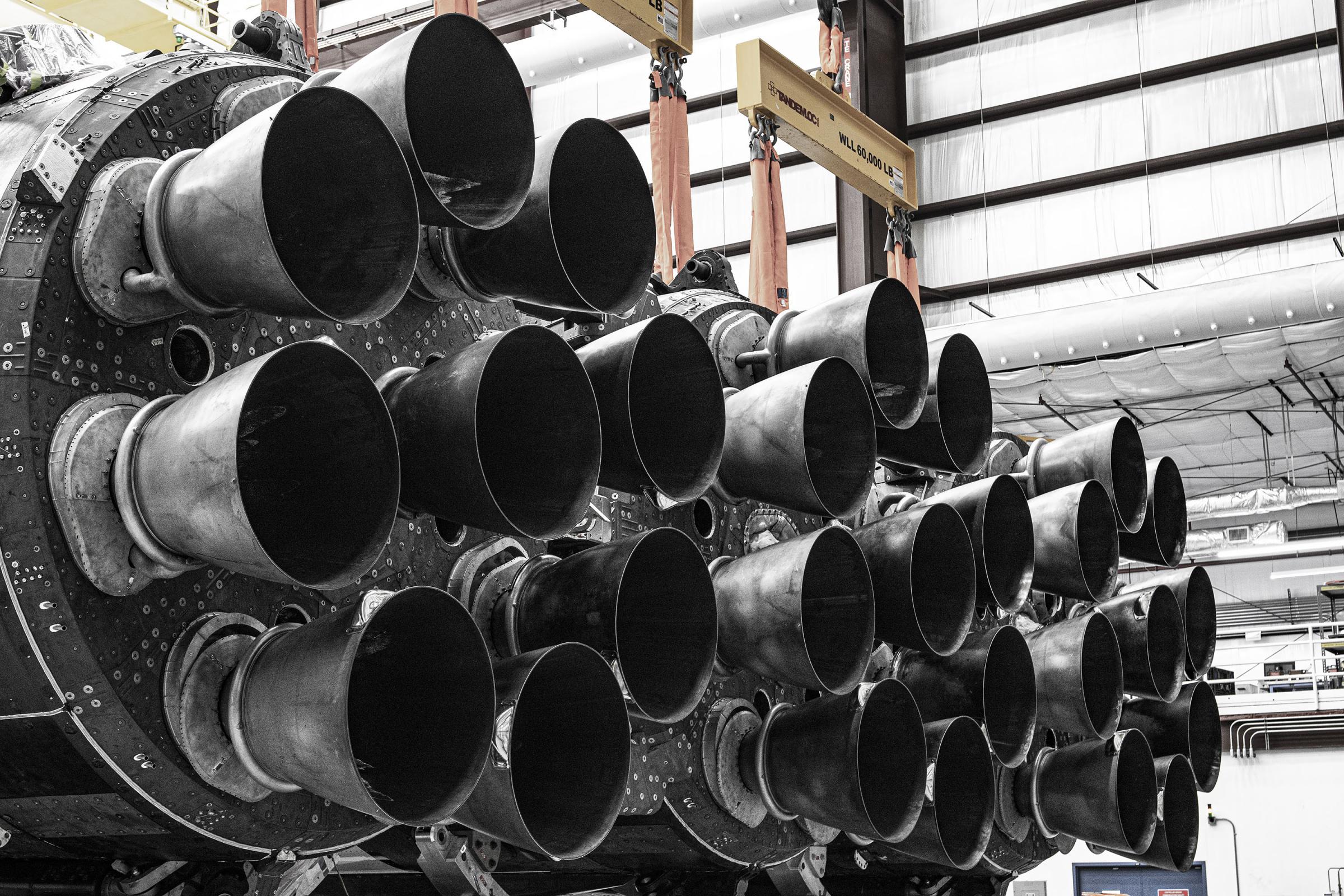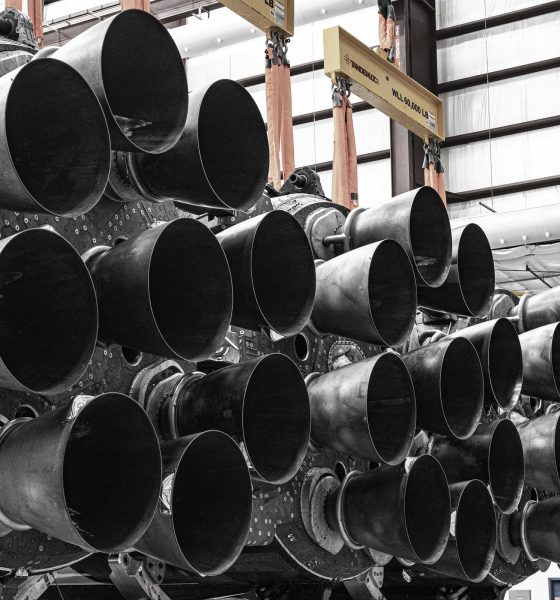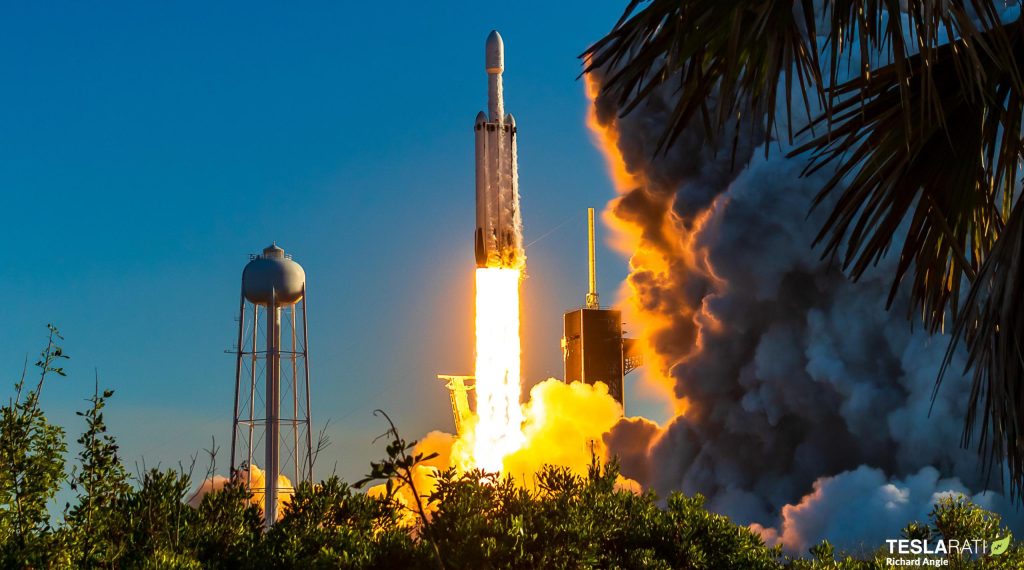

News
SpaceX assembles Falcon Heavy rocket for first launch in 40 months
SpaceX has assembled the fourth Falcon Heavy for the rocket’s first launch in 40 months.
A photo shared by SpaceX on October 23rd shows that it has mated Falcon Heavy’s three first stage boosters together while preparing for prelaunch testing. Simultaneously, workers have completed the equally important task of converting 39A’s transporter/erector (T/E), which has been configured for single-core Falcon 9 rockets for over three years.
The transporter/erectors SpaceX use for all Falcon launches are a bit like a mobile backbone and launch tower combined. Their first purpose is to transport horizontal Falcon rockets to and from their integration hangars and launch pads. They’re also tasked with raising Falcon rockets vertical and lowering them back down for transport or worker access. Most importantly, they connect to a pad’s ground systems and distribute propellant, gases, power, and communications to Falcon 9 and Falcon Heavy through multiple umbilicals and quick-disconnect ports.
Falcon Heavy, which can only be launched out of LC-39A, has three times as many boosters as Falcon 9 and necessitates significant modifications to the pad’s T/E when switching between the two. The process is much harder when moving from F9 to FH, and waiting almost three and a half years between Falcon Heavy launches likely hasn’t made the conversion any easier. But on October 23rd, after numerous tests and weeks of work, the Pad 39A T/E picked up the ‘reaction frame’ that attaches to the bottom of Falcon rockets and was brought horizontal.
Thanks to the nature of Falcon Heavy and Pad 39A’s infrastructure, what happens next is more or less guaranteed. During normal Falcon 9 operations, 39A’s integration hangar is large enough for two or three unrelated Falcon boosters to remain while the T/E rolls inside to pick up a full Falcon 9. More importantly, Falcon 9’s booster and upper stage can technically be integrated off to the side and craned onto the T/E when ready. But with Falcon Heavy, which has a first stage akin to three Falcon 9 boosters sitting side by side, there isn’t enough room inside the hangar to integrate the rocket with the T/E inside.
For Falcon Heavy, the T/E can thus only roll back into the hangar once the rocket’s three boosters and upper stage have been fully assembled and are suspended in mid-air. SpaceX’s October 23rd photo shows that three of the four cranes required for that lift appear to already be in position, further confirming that T/E rollback is imminent. Once the T/E rolls back to the hangar and Falcon Heavy is attached, the rocket will eventually be transported to the pad and brought vertical for wet dress rehearsal (WDR) and static fire testing.
Update: SpaceX began rolling the T/E to Pad 39A’s integration hangar around 1 am EDT, October 24th.
The US Space Force’s USSF-44 payload – a mysterious pair of satellites that are more than two years behind schedule – will almost certainly not be installed on Falcon Heavy during prelaunch testing, so the rocket will need to roll back to the hangar at least one more time after testing to have its payload fairing attached.
Combined, that prelaunch process could easily take a week or more. Multiple sources report that Falcon Heavy is scheduled to launch no earlier than (NET) 9:44 am EDT (13:44 UTC) on Halloween, October 31st. But even if the rocket rolls out today (Oct 24), the odds are stacked against Falcon Heavy sailing through its first integrated prelaunch tests in 40 months, and delays are likely.

For Falcon Heavy’s fourth launch, all three of the rocket’s boosters – B1064, B1065, and B1066 – are new, as are its upper stage and payload fairing. An FCC permit for the launch has confirmed that SpaceX will intentionally expend the rocket’s new center core while its twin side boosters will attempt a near-simultaneous landing back at Cape Canaveral. USSF-44 will be SpaceX’s first attempted launch directly to geostationary orbit (GEO), an exceptionally challenging mission that requires the rocket’s upper stage to coast in space for around 4-6 hours between two major burns.
If successful, Falcon Heavy will insert the USSF-44’s mystery satellites into a circular orbit ~35,600 kilometers (~22,150 mi) above Earth’s surface. At that altitude, orbital velocity matches Earth’s rotation and spacecraft can effectively hover – indefinitely – above their region of choice.
Falcon Heavy is the most powerful operational rocket in the world. At liftoff, it weighs around 1420 tons (~3.1M lb) and can produce more than 2300 tons (~5.1M lbf) of thrust. In a fully expendable configuration, Falcon Heavy can launch 26.7 tons (59,000 lb) to an elliptical geostationary transfer orbit and 63.8 tons (141,000 lb) to low Earth orbit. SpaceX doesn’t advertise its direct-to-GEO capabilities.

Elon Musk
Elon Musk’s X will start using a Tesla-like software update strategy
The initiative seems designed to accelerate updates to the social media platform, while maintaining maximum transparency.

Elon Musk’s social media platform X will adopt a Tesla-esque approach to software updates for its algorithm.
The initiative seems designed to accelerate updates to the social media platform, while maintaining maximum transparency.
X’s updates to its updates
As per Musk in a post on X, the social media company will be making a new algorithm to determine what organic and advertising posts are recommended to users. These updates would then be repeated every four weeks.
“We will make the new 𝕏 algorithm, including all code used to determine what organic and advertising posts are recommended to users, open source in 7 days. This will be repeated every 4 weeks, with comprehensive developer notes, to help you understand what changed,” Musk wrote in his post.
The initiative somewhat mirrors Tesla’s over-the-air update model, where vehicle software is regularly refined and pushed to users with detailed release notes. This should allow users to better understand the details of X’s every update and foster a healthy feedback loop for the social media platform.
xAI and X
X, formerly Twitter, has been acquired by Elon Musk’s artificial intelligence startup, xAI last year. Since then, xAI has seen a rapid rise in valuation. Following the company’s the company’s upsized $20 billion Series E funding round, estimates now suggest that xAI is worth tens about $230 to $235 billion. That’s several times larger than Tesla when Elon Musk received his controversial 2018 CEO Performance Award.
As per xAI, the Series E funding round attracted a diverse group of investors, including Valor Equity Partners, Stepstone Group, Fidelity Management & Research Company, Qatar Investment Authority, MGX, and Baron Capital Group, among others. Strategic partners NVIDIA and Cisco Investments also continued support for building the world’s largest GPU clusters.
News
Tesla FSD Supervised wins MotorTrend’s Best Driver Assistance Award
The decision marks a notable reversal for the publication from prior years, with judges citing major real-world improvements that pushed Tesla’s latest FSD software ahead of every competing ADAS system.

Tesla’s Full Self-Driving (Supervised) system has been named the best driver-assistance technology on the market, earning top honors at the 2026 MotorTrend Best Tech Awards.
The decision marks a notable reversal for the publication from prior years, with judges citing major real-world improvements that pushed Tesla’s latest FSD software ahead of every competing ADAS system. And it wasn’t even close.
MotorTrend reverses course
MotorTrend awarded Tesla FSD (Supervised) its 2026 Best Tech Driver Assistance title after extensive testing of the latest v14 software. The publication acknowledged that it had previously criticized earlier versions of FSD for erratic behavior and near-miss incidents, ultimately favoring rivals such as GM’s Super Cruise in earlier evaluations.
According to MotorTrend, the newest iteration of FSD resolved many of those shortcomings. Testers said v14 showed far smoother behavior in complex urban scenarios, including unprotected left turns, traffic circles, emergency vehicles, and dense city streets. While the system still requires constant driver supervision, judges concluded that no other advanced driver-assistance system currently matches its breadth of capability.
Unlike rival systems that rely on combinations of cameras, radar, lidar, and mapped highways, Tesla’s FSD operates using a camera-only approach and is capable of driving on city streets, rural roads, and freeways. MotorTrend stated that pure utility, the ability to handle nearly all road types, ultimately separated FSD from competitors like Ford BlueCruise, GM Super Cruise, and BMW’s Highway Assistant.
High cost and high capability
MotorTrend also addressed FSD’s pricing, which remains significantly higher than rival systems. Tesla currently charges $8,000 for a one-time purchase or $99 per month for a subscription, compared with far lower upfront and subscription costs from other automakers. The publication noted that the premium is justified given FSD’s unmatched scope and continuous software evolution.
Safety remained a central focus of the evaluation. While testers reported collision-free operation over thousands of miles, they noted ongoing concerns around FSD’s configurable driving modes, including options that allow aggressive driving and speeds beyond posted limits. MotorTrend emphasized that, like all Level 2 systems, FSD still depends on a fully attentive human driver at all times.
Despite those caveats, the publication concluded that Tesla’s rapid software progress fundamentally reshaped the competitive landscape. For drivers seeking the most capable hands-on driver-assistance system available today, MotorTrend concluded Tesla FSD (Supervised) now stands alone at the top.
News
Elon Musk’s Grokipedia surges to 5.6M articles, almost 79% of English Wikipedia
The explosive growth marks a major milestone for the AI-powered online encyclopedia, which was launched by Elon Musk’s xAI just months ago.

Elon Musk’s Grokipedia has grown to an impressive 5,615,201 articles as of today, closing in on 79% of the English Wikipedia’s current total of 7,119,376 articles.
The explosive growth marks a major milestone for the AI-powered online encyclopedia, which was launched by Elon Musk’s xAI just months ago. Needless to say, it would only be a matter of time before Grokipedia exceeds English Wikipedia in sheer volume.
Grokipedia’s rapid growth
xAI’s vision for Grokipedia emphasizes neutrality, while Grok’s reasoning capabilities allow for fast drafting and fact-checking. When Elon Musk announced the initiative in late September 2025, he noted that Grokipedia would be an improvement to Wikipedia because it would be designed to avoid bias.
At the time, Musk noted that Grokipedia “is a necessary step towards the xAI goal of understanding the Universe.”
Grokipedia was launched in late October, and while xAI was careful to list it only as Version 0.1 at the time, the online encyclopedia immediately earned praise. Wikipedia co-founder Larry Sanger highlighted the project’s innovative approach, noting how it leverages AI to fill knowledge gaps and enable rapid updates. Netizens also observed how Grokipedia tends to present articles in a more objective manner compared to Wikipedia, which is edited by humans.
Elon Musk’s ambitious plans
With 5,615,201 total articles, Grokipedia has now grown to almost 79% of English Wikipedia’s article base. This is incredibly quick, though Grokipedia remains text-only for now. xAI, for its part, has now updated the online encyclopedia’s iteration to v0.2.
Elon Musk has shared bold ideas for Grokipedia, including sending a record of the entire knowledge base to space as part of xAI’s mission to preserve and expand human understanding. At some point, Musk stated that Grokipedia will be renamed to Encyclopedia Galactica, and it will be sent to the cosmos.
“When Grokipedia is good enough (long way to go), we will change the name to Encyclopedia Galactica. It will be an open source distillation of all knowledge, including audio, images and video. Join xAI to help build the sci-fi version of the Library of Alexandria!” Musk wrote, adding in a later post that “Copies will be etched in stone and sent to the Moon, Mars and beyond. This time, it will not be lost.”








